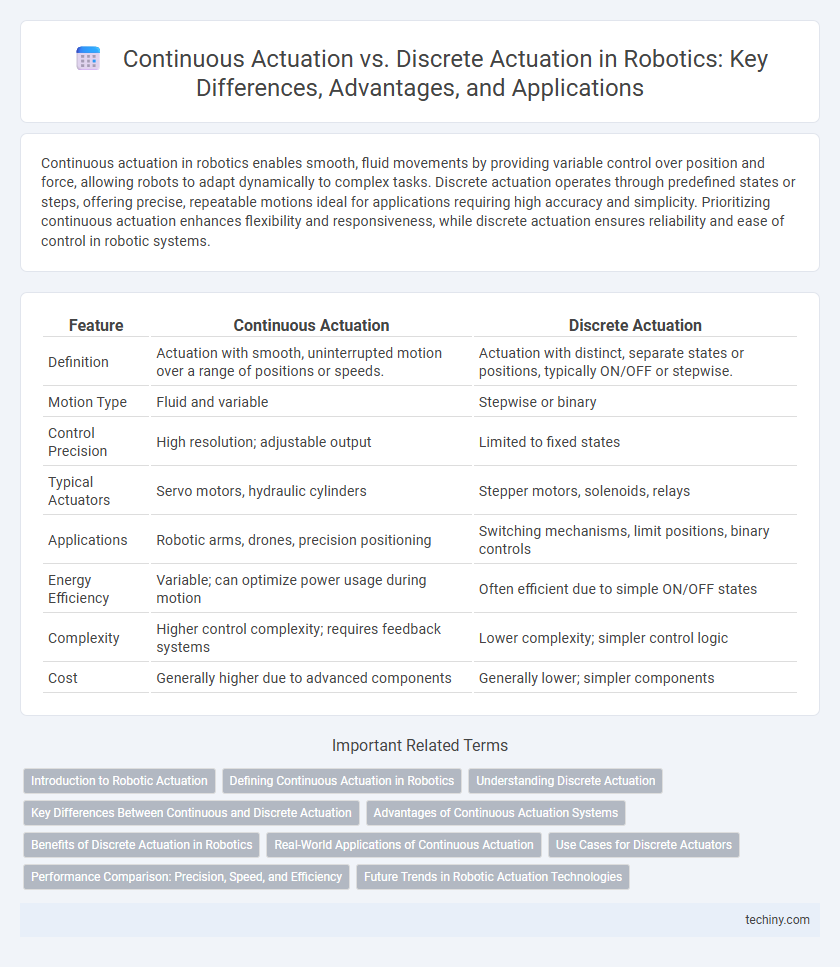Continuous actuation in robotics enables smooth, fluid movements by providing variable control over position and force, allowing robots to adapt dynamically to complex tasks. Discrete actuation operates through predefined states or steps, offering precise, repeatable motions ideal for applications requiring high accuracy and simplicity. Prioritizing continuous actuation enhances flexibility and responsiveness, while discrete actuation ensures reliability and ease of control in robotic systems.
Table of Comparison
| Feature | Continuous Actuation | Discrete Actuation |
|---|---|---|
| Definition | Actuation with smooth, uninterrupted motion over a range of positions or speeds. | Actuation with distinct, separate states or positions, typically ON/OFF or stepwise. |
| Motion Type | Fluid and variable | Stepwise or binary |
| Control Precision | High resolution; adjustable output | Limited to fixed states |
| Typical Actuators | Servo motors, hydraulic cylinders | Stepper motors, solenoids, relays |
| Applications | Robotic arms, drones, precision positioning | Switching mechanisms, limit positions, binary controls |
| Energy Efficiency | Variable; can optimize power usage during motion | Often efficient due to simple ON/OFF states |
| Complexity | Higher control complexity; requires feedback systems | Lower complexity; simpler control logic |
| Cost | Generally higher due to advanced components | Generally lower; simpler components |
Introduction to Robotic Actuation
Continuous actuation in robotics enables smooth, variable motion through mechanisms such as electric motors and hydraulic drives, allowing precise control over speed and position. Discrete actuation operates through distinct, predefined states using components like solenoids or stepper motors, often ideal for applications requiring simple on-off control or incremental movements. Understanding the trade-offs between continuous and discrete actuation informs the design of robotic systems optimized for flexibility, precision, and energy efficiency.
Defining Continuous Actuation in Robotics
Continuous actuation in robotics refers to the ability of robotic actuators to produce smooth, uninterrupted motion over a range of positions or speeds, allowing for precise control and adaptability in dynamic environments. Unlike discrete actuation, which operates in fixed, separate steps or positions, continuous actuators use mechanisms such as electric motors, hydraulic cylinders, or pneumatic muscles to achieve fluid movement and variable output. This capability is essential for tasks requiring fine manipulation, complex navigation, and responsive interaction with unpredictable surroundings.
Understanding Discrete Actuation
Discrete actuation in robotics involves motors or actuators that move in fixed steps or positions, enabling precise control over movements with clearly defined states. This method is essential for applications requiring repeatability and accuracy, such as robotic grippers or stepper motor-driven joints. Compared to continuous actuation, discrete actuation simplifies control algorithms by focusing on distinct, measurable increments rather than fluid, variable motion.
Key Differences Between Continuous and Discrete Actuation
Continuous actuation enables smooth, uninterrupted motion with variable speed and position control, essential for applications requiring fluid and precise movements, while discrete actuation operates in distinct steps or positions, ideal for tasks demanding binary or limited positional changes. Continuous actuators include servo motors and hydraulic systems providing fine-grained control, whereas discrete actuators commonly use solenoids, stepper motors, and switches that toggle between fixed states. Understanding these fundamental differences guides the selection of appropriate actuators in robotics based on movement complexity, control requirements, and energy efficiency.
Advantages of Continuous Actuation Systems
Continuous actuation systems in robotics offer precise control through smooth, uninterrupted motion, which enhances the accuracy of tasks requiring delicate manipulation. These systems enable more natural and adaptive movements by providing variable speed and torque, improving overall robot performance in dynamic environments. Continuous actuation reduces wear and mechanical stress compared to discrete actuation, leading to increased durability and lower maintenance costs.
Benefits of Discrete Actuation in Robotics
Discrete actuation in robotics offers precise control over movement by enabling defined steps, which improves repeatability and accuracy in tasks such as assembly and positioning. This method reduces energy consumption compared to continuous actuation, as actuators operate only when commanded, enhancing overall system efficiency. The inherent simplicity and robustness of discrete actuators allow for easier maintenance and longer operational life, crucial for industrial and service robots in demanding environments.
Real-World Applications of Continuous Actuation
Continuous actuation in robotics enables smooth, precise control of robotic joints and mechanisms, essential for applications such as surgical robots and autonomous drones. This type of actuation allows for fluid motion and adaptability in unstructured environments, improving task accuracy and responsiveness. Real-world deployment of continuous actuators enhances performance in manufacturing automation, prosthetics, and soft robotics where nuanced movement is critical.
Use Cases for Discrete Actuators
Discrete actuators are ideal for robotics tasks requiring precise control of position and state, such as robotic grippers, switches, and stepper motor-driven joints. Their binary operation simplifies control systems, making them suitable for pick-and-place robots, automated assembly lines, and safety mechanisms where distinct ON/OFF states ensure reliability. These actuators excel in applications demanding repeatability and minimized error margins in positioning tasks.
Performance Comparison: Precision, Speed, and Efficiency
Continuous actuation in robotics offers superior precision due to its ability to provide smooth, uninterrupted motion, whereas discrete actuation relies on stepwise movements that can introduce positioning errors. Speed performance favors continuous actuators in applications requiring variable velocities, as they enable rapid acceleration and deceleration without mechanical delays inherent in discrete systems. Efficiency is typically higher in continuous actuation systems because they minimize energy losses by avoiding frequent start-stop cycles common in discrete actuation mechanisms.
Future Trends in Robotic Actuation Technologies
Continuous actuation in robotics enables smooth, precise, and adaptable movements essential for advanced manipulation and locomotion tasks, while discrete actuation offers simplicity and robustness for repetitive or binary actions. Future trends emphasize hybrid actuation systems that combine continuous and discrete mechanisms, leveraging smart materials like electroactive polymers and soft robotics to enhance energy efficiency and responsiveness. Integration of AI-driven control algorithms will further optimize these actuation technologies, enabling more autonomous, flexible, and human-like robotic behaviors across diverse applications.
Continuous actuation vs Discrete actuation Infographic

 techiny.com
techiny.com